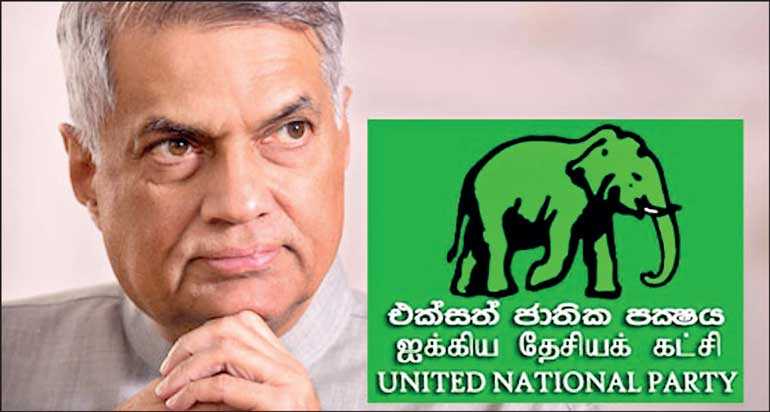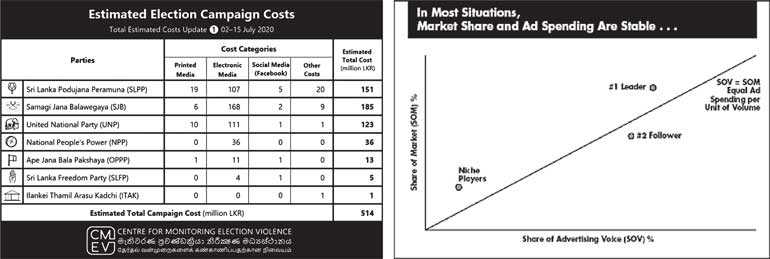Tuesday Dec 09, 2025
Tuesday Dec 09, 2025
Friday, 21 August 2020 00:30 - - {{hitsCtrl.values.hits}}

The UNP spent 24% of share of expenditure SOE but secured only a 2% share

In marketing, we work on a model that if we increase the Share of Voice (SOV) in the marketplace by increasing the marketing spend, it will have a somewhat direct link to the Share of Mind (SOM) of the target consumer group. This increased SOV will in turn will drive behaviour change among consumers that will lead to an increase in the share of  market. However, the recent General Election in Sri Lanka proved this age-old concept wrong.
market. However, the recent General Election in Sri Lanka proved this age-old concept wrong.
Why wrong?
If one does a deep dive on the data available as per the Centre for Monitoring Election Violence, brand SLPP has invested Rs. 151 million with a share of voice (SOV) of 29% to get a share of market of 59%. On the other hand, the SJB has incurred a spend of Rs. 185 million (a 34% SOV) to get a market share of 24%. The UNP has invested Rs. 123 million with a SOV of 23% but was able to get only a share of 2%.
Let’s go back to understand what the theory says. In general situations the market share and ad spending are stable to gain market share, a competitor resorts to a huge ad spending push market share. This works on the premise that the other variables that impact behaviour are somewhat similar in nature such as product attributes, pricing strategies, availability of the product and the current market share of the brand.
In this light the SLPP spending a 29% SOV to get a 59% market share is a strong performance that can be attributable to the people believing the product promise due to past performance of the brand. On the other hand a 23% SOV by the UNP for a 2% market share means that the product promise that was communicated failed to attract the people to vote. Hence we see that SOV=SOM market works when other variables complement each other. It also tells us what a brand must do to increase the market share in the future.
Ad spending and market share
If we go into the science of marketing we see from the chart on the relationship between advertising spending to market share in consumer packaged goods industries how in a competitive equilibrium situation, the largest and smallest players each enjoy a share of market (SOM) somewhat bigger than their share of ad spending (SOV).
Hence we see that a small player will have to spend more to get share like what we saw of the SJB having to spend Rs. 185 million or a share of voice (SOV) of 34% to get a share of 23%, whilst a dominant brand like SLPP had to spend only a 29% share of voice to get a 59% market share.
Case in point – US
If I go back to the 2016 US elections, it was a dead heat at a 44% share of both candidates and it was clear that Clinton would pull through. In fact technically brand Clinton won with a higher number of votes but due to the electoral voter system the second brand came into office. If the latter was not in play it was a classic case study of SOV = SOM = Market share in my view.
If this analogy is extrapolated to Sri Lanka general elections 2020 the brand SLPP had a higher product reputation given the performance of the management of COVID-19 and that the President freed the country from war way back in 2009. On the other hand the UNP was coming to the elections post a disastrous performance such as the famous Central Bank bond scam and the Easter attacks that proved the poor management capability of the brand. Hence the former (SLPP) had to invest lesser funds (SOE) with a lesser SOV to garner strong per SOM. On the other hand the latter (UNP) even with a higher spend (SOE) was able to elucidate a lower share of market.
Just like the US situations if the products powered the same strength, then there would have been a stronger equilibrium between SOV=SOM.
Insight to action
What is important now is understand the logic behind the numbers so that we can use the insights to brand marketing and that we will know how to manage our brands to moving consumer behaviour.
Especially when it comes to a political campaigns the essence of strong strategy is a research-driven action – the ability to convert insight about a customer and competitors into a superior strategic position and a plan that persuades voters to choose a specific candidate are classic cases in points that can give strong insights to day to day brand management in organisations. From a political sense the implications is that how each of the campaigns understands the hidden nuances and then converts this insight to strategy in the future.
For instance, people believed the SLPP brand promise better than any other brand. Now the promise will have to be delivered. Rural consumers will not be interested in GDP growths declining and recessionary economic conditions globally and the implications to Sri Lanka. They will now demand the brand SLPP deliver on the promises. I guess the product-based State minister structure gives clear responsibility even though from an image basis it may sound funny. The point to note is what Sri Lanka require now is performance and not perception issues. I strongly support the product based State minister tag like State Minister for Chillies, etc., just like a corporate brand management structure.
On the other hand the brand UNP will have to re structure the product and come out with a totally new look and feel if the entity wants to make any come back in the future. This will include serious reforms just like what a company does when we lose market share. I guess from 100+ seats if one comes down to zero one does not need a Harvard mind to know that the total product needs re constitution. But sadly we see how the CEO of the brand UNP is destroying the organisation and I guess the team that is supporting the leader must also take responsibility for the situation as it all directs to poor leadership.
On the other hand spending 34% share of expenditure by brand SJB for a 23% share can be justifiable as it’s a new brand in the market place even though the product composition are known. It will be interesting to see how the leadership builds this brands in the future. It can take the SLPP brand building route or go back and merge with the UNP which can be disastrous unless a major brand overhaul is done in the event this is done.
Marketing right?
Given the above analysis strictly from a marketing perspective, one can argue if marketing a political candidate to high office like a washing powder or a toilet soap is an ultimate indignity to the democratic process of a country? The logic for the argument is because can the general public be influenced with a SOV = SOM = Market share equation?
The answer has been challenged by many on an ethical front but the reality is that marketing drives voter behaviour and be it right or wrong the party that does a better job on this equation will become the choice selected, be it in Sri Lanka or anywhere in the world.
What is marketing?
Let me go back to the basics. Let’s simply understand what marketing means. The Chartered Institute of Marketing defines marketing as a management process that identifies what a customer wants and thereafter develops a solution (product) to meet these requirements better than competitors but in a socially responsible manner. In the case of politics, the customer is the voter and the provider is the politician.
Based in this grounding a candidate that can understand the ground reality and better articulate a product with the right message strength will be able to garner a stronger mandate of the people. If a person cannot do this then they get kicked out just like what we saw in the General Elections 2020.
So a candidate who can effectively communicate how these needs can be addressed better with their overall solution will garner the support to be voted in at an election, which incidentally is marketing at its best. It would not be incorrect to say that it is the discipline of marketing that brings democracy into a system.
Is marketing right?
The logic on the democracy ethos is that it is marketing that brings in democracy to a system for two reasons, the first being that the product/service that is offered by a candidate must communicated effectively in a manner so that the consumer is better informed on who best fits their requirement. The second being that unless the product advertised has credibility on the performance then one will not get picked up. Hence the concept ‘marketing a political candidate to high office’ can be justified.
When marketing is wrong
Where marketing comes in for criticism is when marketing a candidate is done not in a socially acceptable manner. This includes blocking of media, below-the-line rivalry at meetings, voters not being allowed to vote, unlawful voting, etc.
But a point to note is that this behaviour is not confined to political marketing but it happens across many consumer brands too, of which I have first-hand experience, which is an interesting parallel that many are not aware of.
The second point where marketing as a discipline draws flak is when used in politics, a candidate fails to deliver on the promise made after being elected. The best case in point was the UNP as a brand that ultimately got kicked out.
Summary
Hence we see that in the next few months the focus will be on the 19th Amendment and many have different opinions on this subject. The bigger challenge to my mind will be how the SLPP become more competent on the skill of marketing and delivery on the said promises. The logic being that when the Q1 GDP (prior to COVID-19) declined by -1.6%, which means that Q2 is heading for a -4% showdown then we have to do some serious work to drive a V shape recovery.
(The writer is a CEO of an Artificial Intelligence company in the South Asian region and owns a portfolio of companies.)